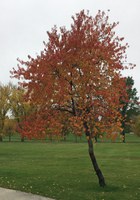Dakota Gardener: Being Tough and Getting Older
(Click an image below to view a high-resolution image that can be downloaded)
By Joe Zeleznik, Forester
NDSU Extension
“Getting old isn’t for sissies.”
I heard that from Jack Carter, who was North Dakota State University’s flax breeder for many years. Carter came into the office nearly every day, well into his 80s.
He had a great point. Physical demands are tougher as we age.
What about trees? Is life tougher for them as they age? Even tree species that are short-lived should be able to survive 20 or 30 years.
How do they do it? The annual cycle of growth, senescence and dormancy goes on, and yet the environment is slightly different each year. How do the trees survive, and even thrive?
Admittedly, the stressful environment of North Dakota shortens the lifespan of many trees. Extremes of moisture and temperature take their toll. Just one week of flooding is likely to kill a spruce tree, although a cottonwood can handle that stress with minimal problems.
Extreme low temperatures in midwinter kill trees every year, especially those that are from seeds farther south. We often use the U.S. Department of Agriculture’s Hardiness Zones as a guideline for which species or varieties might be adapted to North Dakota.
In autumn, trees go through the process of hardening to prepare for winter dormancy. The environmental cues that begin the hardening process are shorter days and cooler temperatures.
However, other factors come into play. Trees that are growing vigorously don’t harden as quickly or as much as they should. I see this every year in yards that are highly fertilized and irrigated.
The trees barely slow their growth in the fall, and they don’t completely harden up for winter. The damage shows up the following spring as dead branch tips, or in the worst cases, dead trees.
So what can we do? Believe it or not, a little bit of drought stress in August is actually a good thing. The process that trees use to respond to drought is related to the process they use to harden up in the fall.
So, in giving trees a little bit of stress, we’re actually helping them. Nurseries do this every year as part of tree production. They cut back on watering to slow the trees’ growth.
Should you shut down the irrigation system in your yard during August? Well, for the sake of the trees, yes. Of course, there’s a tradeoff. The grass won’t be quite so lush, and it might not even be green. But the trees will slow, and that’s good. Side benefit – less mowing!
The hardening process is also what gives us those beautiful fall colors that we enjoy every year. Without hardening, we miss the vibrant yellows, oranges, reds and purples that nature provides.
When my wife and I bought our current home in 2013, it came with two beautiful maple trees and an irrigation system. For the first few years, the maples didn’t provide that brilliant fall color that we expected.
Then I realized that I hadn’t turned off the irrigation during August. I finally remembered to do that in 2016 and the maples were beautiful that fall.
I know it sounds weird, but try stressing your trees, at least a little bit. It’s good for them.
For more information about gardening, contact your local NDSU Extension agent. Find the Extension office for your county at https://www.ag.ndsu.edu/extension/directory/counties.
NDSU Agriculture Communication - Aug. 25, 2020
| Source: | Joe Zeleznik, 701-231-8143, joseph.zeleznik@ndsu.edu |
|---|---|
| Editor: | Ellen Crawford, 701-231-5391, ellen.crawford@ndsu.edu |




